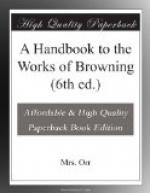“But life in the flesh is good, showering gifts alike on sense and brain. It is right that at some period of its existence man’s heart should beat in unison with it; that having seen God’s power in the scheme of creation, he should also see the perfectness of His love; that he should thank Him for his manhood, for the power conferred on him to live and learn. And this boon must be granted by age, which gathers in the inheritance of youth.”
“The inheritance is not one of earthly wisdom. Man learns to know the right and the good, but he does not learn how outwardly to apply the knowledge; for human judgments are formed to differ, and there is no one who can arbitrate between them. Man’s failure or success must be sought in the unseen life—not in that which he has done, but in that which he has aspired to do.”
“Nothing dies or changes which has truly BEEN. The flight of time is but the spinning of the potter’s wheel to which we are as clay. This fleeing circumstance is but the machinery which stamps the soul (that vessel moulded for the Great Master’s hand). And its latest impress is the best: though the base of the cup be adorned with laughing loves, while skull-like images constitute its rim.”
“Look not thou down but
up!
To uses of a cup,
The festal board, lamp’s flash and trumpet’s-peal,
The new wine’s foaming flow,
The Master’s lips a-glow!
Thou, heaven’s consummate cup, what needst
thou with earth’s
wheel?”
(vol.
vii. p. 119)
“DEAF AND DUMB” conveys, in a single stanza, the crowning lesson of the life of Paracelsus, and indeed of every human life: for the sculptured figures to which it refers have supplied the poet with an example of the “glory” which may “arise” from “defect,” the power from limitation. It needs, he says, the obstructing prism to set free the rainbow hues of the sunbeam. Only dumbness can give to love the full eloquence of the eyes; only deafness can impress love’s yearnings on the movements of neck and face.
“THE STATUE AND THE BUST” is a warning against infirmity of purpose. Its lesson is embodied in a picturesque story, in which fact and fiction are combined.
In the piazza of the SS. Annunziata at Florence is an equestrian statue of the Grand Duke Ferdinand the First, representing him as riding away from the church, and with his head turned in the direction of the once Riccardi Palace, which occupies a corner of the square. Tradition asserts that he loved a lady whom her husband’s jealousy kept a prisoner there, and whom he could only see at her window; and that he avenged his love by placing himself in effigy where his glance could always dwell upon her.




